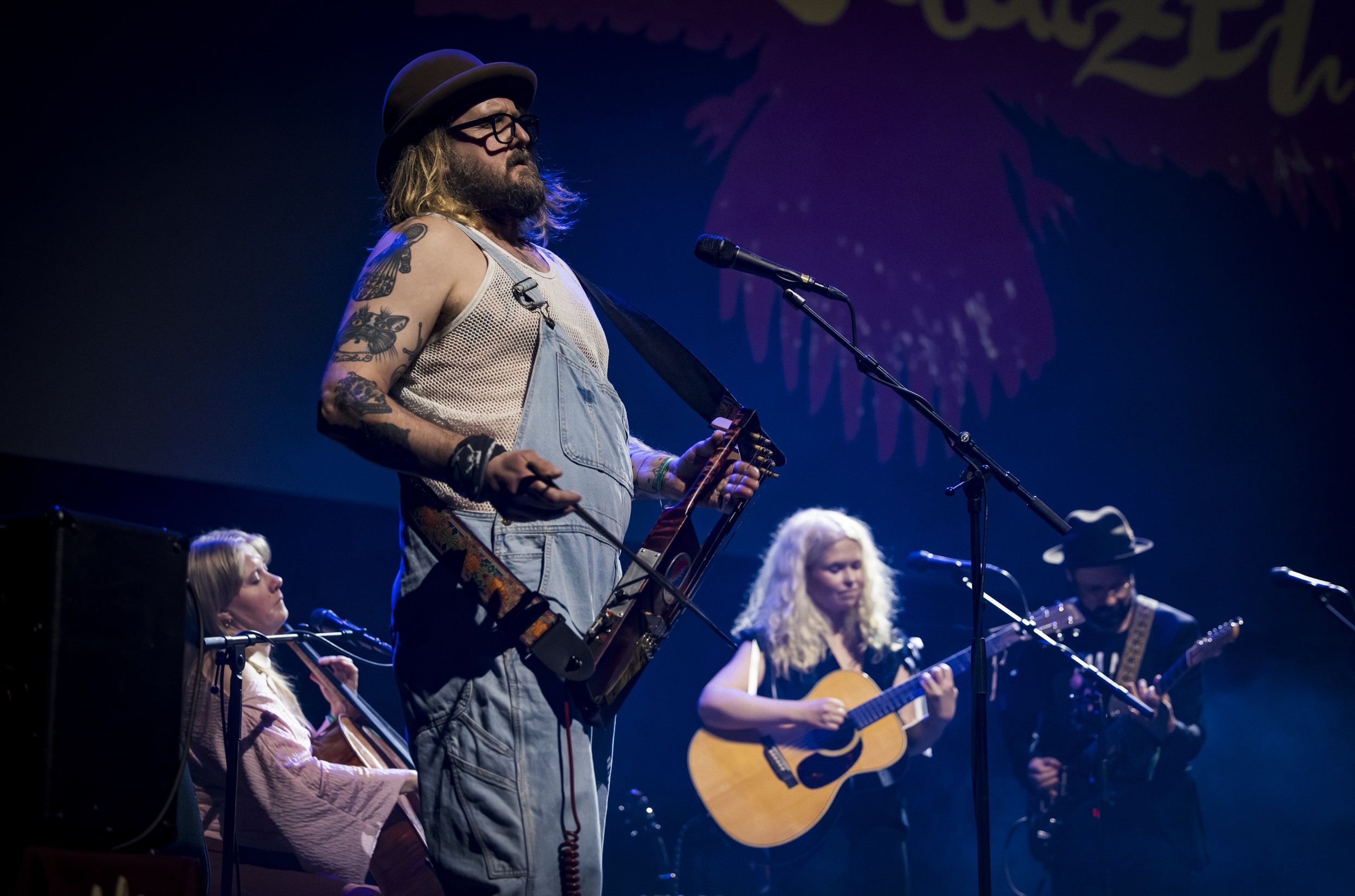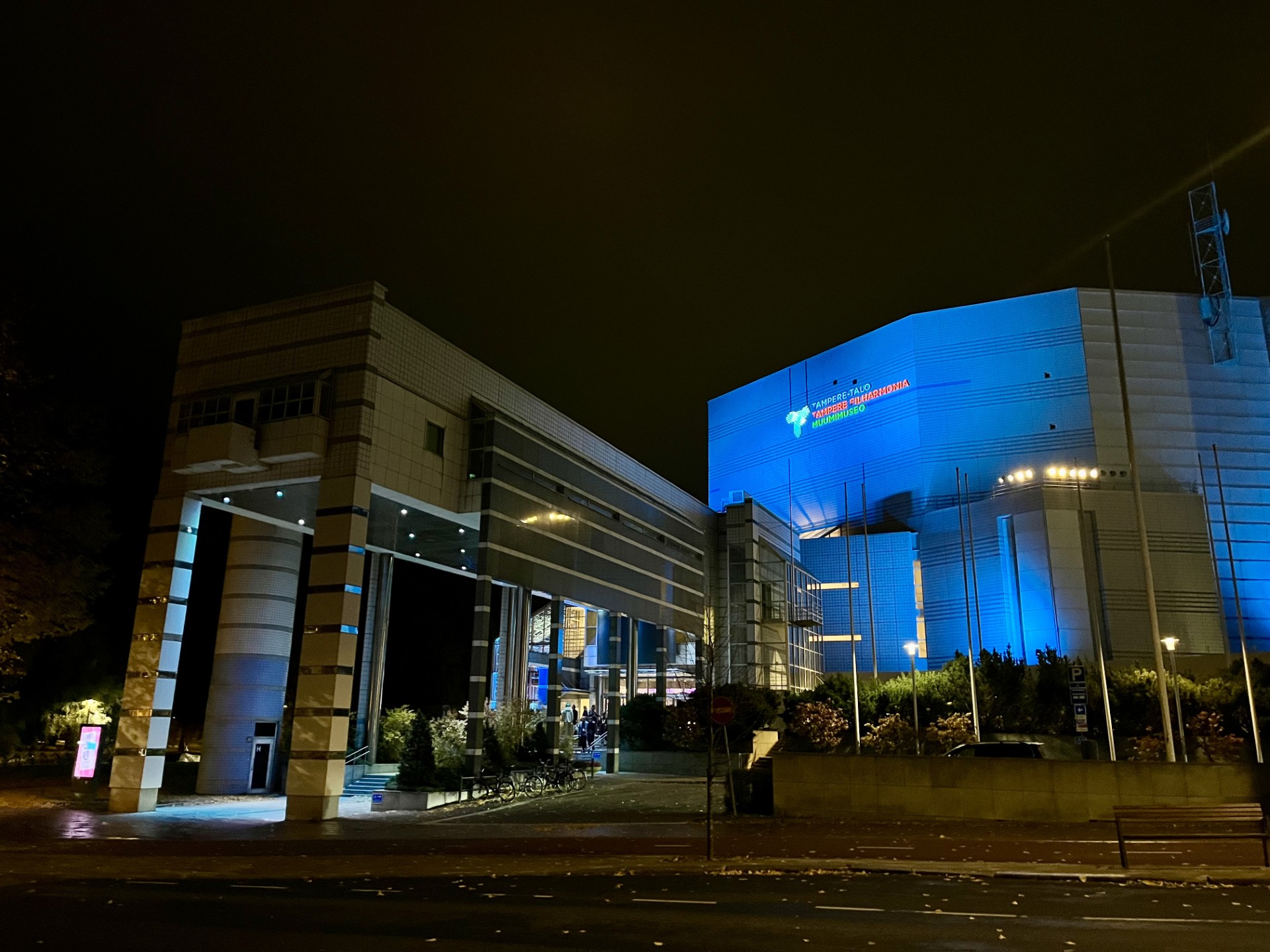WOMEX is the world’s biggest expo of the world’s music, this year in Tampere, Finland. And the opening concert in the Tampere Talo is the chance for the host country to put their cards on the table and present their musical riches to an international audience. So it’s always interesting to see what is presented. Sometimes it’s nationalistic, sometimes unintelligible, or sometimes a carefully chosen selection of four artists, as in Tampere, that says something about the current music scene in Finland to the world. The concert was broadcast live on TV by YLE Teema.
Ne Lintuizet evokes echoes of the folkrevival
The show opened with the local Tampere band, Ne Lintuizet (Those Birdz), led by jouhikko player Pekko Käppi. They are an acoustic four-piece harking back to the American folk revival of the late 60s and 70s: two acoustic guitars, jouhikko and cello, all of them singing. There are nice harmony vocals and some instrumental solos. The most played song on their album Uusi Huone (New Room) is ‘Laatikkoon’ (Into the box), a cover of the Malvina Reynolds song ‘Little Boxes’ first made famous by Pete Seeger in 1963. Little boxes ‘all made out of ticky-tacky’ which all look just the same. That song was not in the concert, but Ne Lintuizet are about references to that American folk revival which had its reverberations in Finland as well.
The songs of the opening concert are all original. Their sound is sweet, but they have this quirky instrument, the jouhikko a ‘primitive’ bowed lyre which had virtually died out till Pekko Käppi and a few other players resurrected it, and it now has a distinct presence on the Finnish musical scene. So here it is in this group, but I’m not really hearing it, until the third song ‘Maailma on kallellaan’ (The world is tilted) when Käppi stood up to give a blistering solo on the instrument. The medieval lyre goes rock’n’roll and the energy kicks in.

The spirit of the north
The second act were Sami group Áššu (Ember) featuring singer Ulla Pirttijärvi, who is one of the great Sami singers of Finland. Indigenous inhabitants of the northern part of the country, she starts by creating a winter’s windy landscape with just her breath. The wind roars and you feel a snowy, wintery landscape with empty space all around. Then the musical partners join, Olav Torget on electric guitar and Kenneth Ekornes on percussion – not a drum kit, but evocative drums, chimes and bells. Pirttijärvi starts singing a joik with that guttural gravelly voice. Joiks are usually not formed of words but sounds to evoke a person, a place or an animal. Her first joik was her brother’s, who’s a reindeer herder, hence the breadth of the windy landscape. The next was the joik of a friend, Ursula, who from the music sounds like a fun and easygoing person.
The final joik was ‘an old joik from Angeli’ as Pirttijärvi described it, the village where she grew up. She was a member of one of the first Sami groups, Angelin tytöt, in the early 1990s, but has been involved in several Sami music projects since. The final song gave opportunities for guitar and percussion breakouts, whooping from the audience and a good-time joik’n’roll experience.
.jpg)
A musical wake-up call
The most dramatic moment in the concert was when accordionist Kimmo Pohjonen, dressed in his kimono skirt, came on and stroked the bellows of his instrument and the screen behind the stage lit up with images of a burning planet. The accordion produced sounds of thunder, or of gunfire. It was a visceral moment. In the first few minutes we had images of global destruction, portraits of nasty world leaders – some I could identify, some not – and music that was loud, challenging and clearly screaming a message. After the horrors of world destruction, things relaxed and Pohjonen was almost dancing with the accordion as a ghostly vision of the accordion was projected in space.
Pohjonen started playing traditional accordion when he was given one by his father. But in the 1970s, accordion wasn’t cool and he hid it from his friends. But he persisted with it and joined the second-year course of the Folk Music Department of the Sibelius Academy, that has done so much to invigorate the folk music scene in Finland. At the Sibelius Academy he was doing classical accordion but also got interested in more contemporary stuff with electronics. And he did a showcase at WOMEX in Berlin in 1999 that launched his international career – with Kronos Quartet and many other international groups.
Kimmo Pohjonen has done a lot of concerts with looping and pre-recorded tracks, but this concert was all live: the videos and the percussive effects plus accordion and vocals, all triggered through the accordion. How it’s done, I don’t know, but he assures me everything is done live.
At the end there are aerial shots of forest ploughed up – nature being industrialised. Since the war in Ukraine, Finland isn’t buying material from Russia, so Finnish forests are being destroyed in larger numbers. Pohjonen is a musician with an urgent message, if it’s not always clear what he means.
.jpg)
Värttinä weaves witches, whisks and harmony
And finally, Värttinä, the band that put Finland on the world music map in 1990 and have been a consistent presence in various line-ups since then. They won the main WOMEX artist award in 2012 – a kind of life-time achievement prize. But they’ve recently released Kyly, a superb album that features their close harmony vocals, infectious rhythms and a theatrical vision. They come on stage laughing and chattering like three witches. Macbeth’s witches transported into Karelia. With sauna whisks, magical herbs and a shamanistic stick, they are creating spells to drive the evil away from the sauna.
‘Kyly’ is Karelian for sauna, just as central to life as it is in Finland. It’s a vivid performance and transforms from a chanting to a song with more melody. It takes you somewhere. The song ‘Maaruska’, about a woman having to leave home, is a singable hit from the album and their closing is ‘Seleniko’, an energetic song from 1992, which many in the audience were able to sing along to. It certainly showed their longevity in the Finnish and international music world.
.jpg)
Featured photo Simon Broughton
